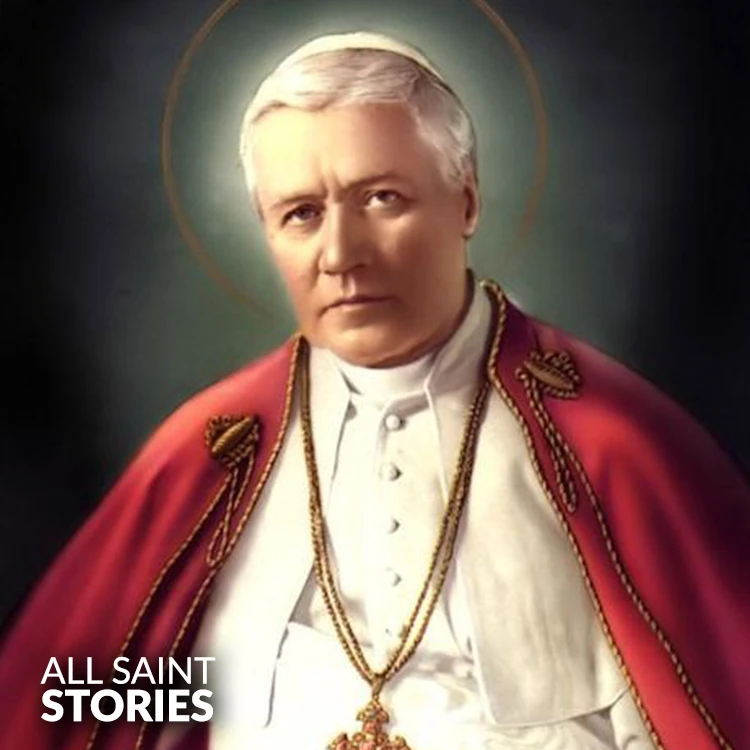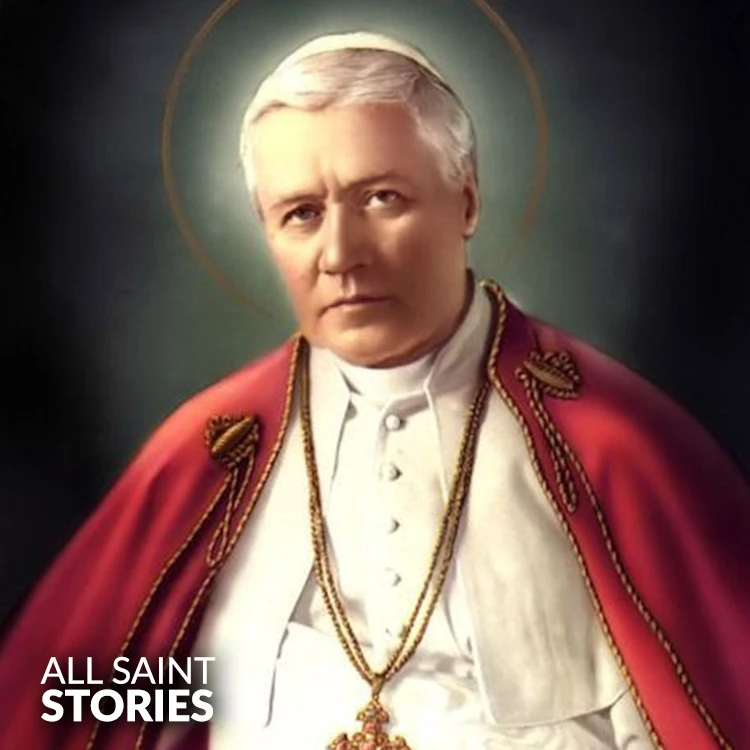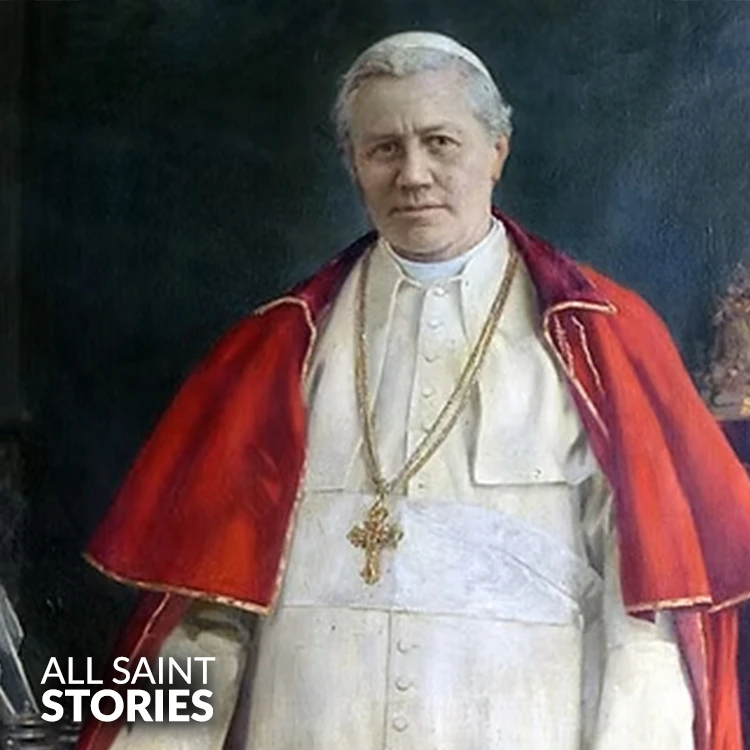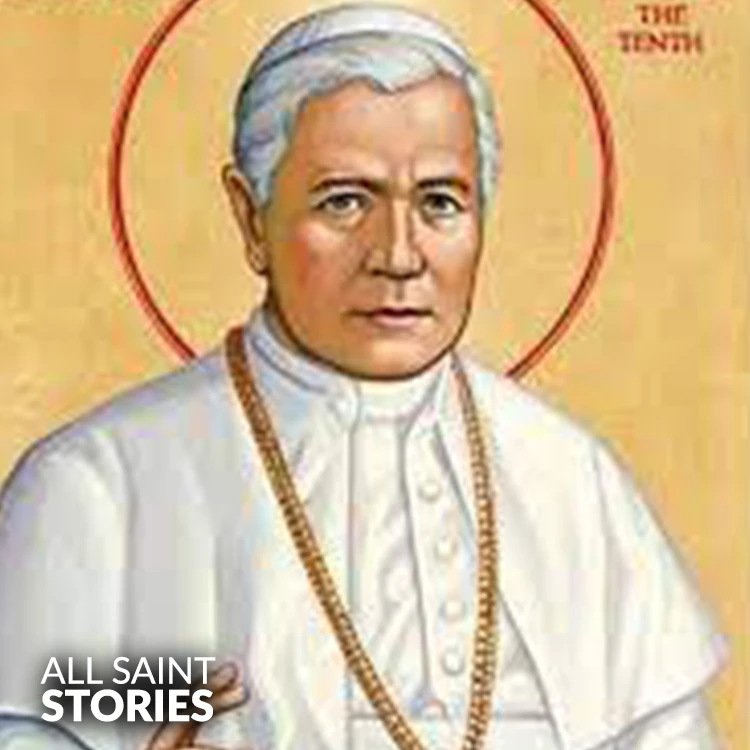Saint Pius X, faithful servant of God, you devoted your life to the Church and the Eucharist. Through your example of humility and love, help us grow in faith, hope, and charity. Intercede for us, that we may live our lives with courage, seeking always to follow Christ's path. Guide and protect us, especially in times of difficulty, and lead us to a deeper relationship with God. Amen.
ST. PIUS X (POPE)
ST. PIUS X (POPE)

Pope St. Pius X, born Giuseppe Sarto in 1835, was a staunch defender of Church tradition and doctrine. As pope from 1903 until his death in 1914, he implemented liturgical reforms, encouraged frequent reception of the Eucharist, and condemned Modernism. His papacy contributed to the codification of Church law, educational reforms, and a renewed focus on the sacraments. Canonized in 1954, he remains a patron of liturgical renewal and Eucharistic devotion.
Pope St. Pius X, born Giuseppe Melchiorre Sarto on June 2, 1835, in Riese, Italy, became the 258th pope of the Roman Catholic Church. He was elected on August 4, 1903, at the age of 68 and led the Church with a firm commitment to tradition, faith, and doctrinal clarity. His papacy lasted until his death on August 20, 1914. St. Pius X is best remembered for his liturgical reforms and his tireless efforts to defend the Church against the rising tide of Modernism. One of his most significant reforms was the encouragement of frequent reception of the Eucharist, particularly for children. Before his papacy, receiving Communion was infrequent, but he promoted the idea that all Catholics, regardless of age, should receive the Body and Blood of Christ regularly.
St. Pius X’s papacy was marked by strong opposition to Modernism, a movement that sought to reconcile Catholic teachings with contemporary science, philosophy, and critical biblical scholarship. In 1907, he issued the encyclical Pascendi Dominici Gregis, which denounced Modernism as a dangerous heresy that threatened to distort the Church’s core teachings. He believed that the Catholic faith should remain faithful to its tradition and not be influenced by modern ideologies. His efforts in combating Modernism were seen as a defense of orthodoxy in a rapidly changing world.
In addition to his theological work, Pope St. Pius X placed great emphasis on education within the Church. He sought to improve the training and knowledge of clergy and laity alike, encouraging the establishment of Catholic schools and better catechetical resources. He also supported the codification of Canon Law, a project that was completed after his death with the publication of the 1917 Code of Canon Law. This was a monumental task that helped to standardize and organize the laws governing the Church.
St. Pius X also had a deep devotion to the Virgin Mary, particularly in her role as the Mother of the Church. His Marian devotion influenced many of his papal decisions, and he emphasized her importance in the life of every Catholic. His papacy also laid the groundwork for later developments in the Church, such as the declaration of the dogma of the Assumption of Mary by his successor, Pope Pius XII, in 1950.
Pope St. Pius X passed away on August 20, 1914, after a period of declining health. He was buried in St. Peter's Basilica in Vatican City, where his tomb remains a place of pilgrimage. His cause for sainthood was introduced shortly after his death, and he was beatified by Pope Pius XI in 1951. On May 29, 1954, he was canonized by Pope Pius XII, becoming a saint of the Catholic Church.
St. Pius X is often regarded as a saint of the Eucharist and a defender of tradition. His reforms and teachings continue to influence the Church, especially in regard to liturgy and the reception of the sacraments. His feast day is celebrated on August 21, and his life and work remain a source of inspiration for Catholics committed to living a life of faith, reverence, and devotion to the teachings of the Church.
Video Not Found
The information on this website is compiled from various trusted sources. While we aim for accuracy, some details may be incomplete or contain discrepancies.
If you notice any errors or have additional information about this saint, please use the form on the left to share your suggestions. Your input helps us improve and maintain reliable content for everyone.
All submissions are reviewed carefully, and your personal details will remain confidential. Thank you for contributing to the accuracy and value of this resource.
Credits & Acknowledgments
- Anudina Visudhar (Malayalam) – Life of Saints for Everyday
by Msgr. Thomas Moothedan, M.A., D.D. - Saint Companions for Each Day
by A. J. M. Mausolfe & J. K. Mausolfe - US Catholic (Faith in Real Life) – Informational articles
- Wikipedia – General reference content and images
- Anastpaul.com – Saint images and reflections
- Pravachaka Sabdam (Malayalam) – Saint-related content and insights
We sincerely thank these authors and platforms for their valuable contributions. If we have unintentionally missed any attribution, please notify us, and we will make the correction promptly.
If you have any suggestion about ST. PIUS X (POPE)
Your suggestion will help improve the information about this saint. Your details will not be disclosed anywhere.
© 2025 Copyright @ www.allsaintstories.com





 English
English
 Italian
Italian
 French
French
 Spanish
Spanish
 Malayalam
Malayalam
 Russian
Russian
 Korean
Korean
 Sinhala
Sinhala
 Japanese
Japanese
 Arabic
Arabic
 Portuguese
Portuguese
 Bantu
Bantu
 Greek
Greek
 German
German
 Dutch
Dutch
 Filipino
Filipino